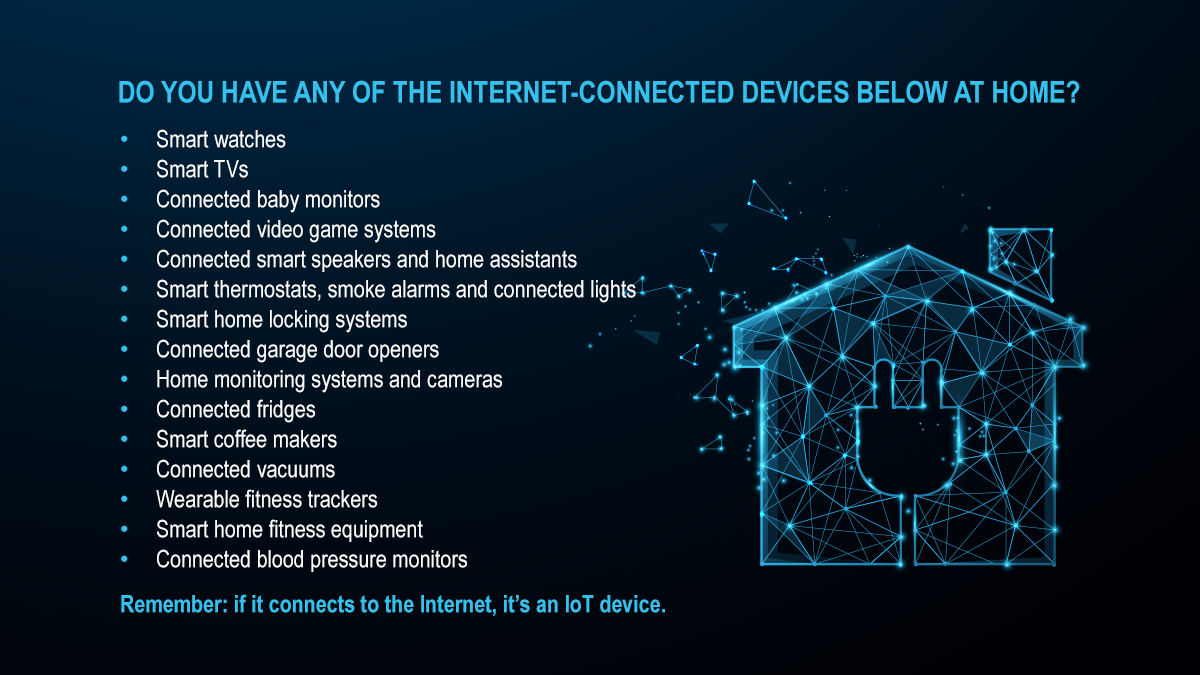Article
Although the term "Internet of Things" (IoT) wasn’t a common household word until recently many, of us now have at least one connected or smart device in our home, in addition to our laptop and mobile phone. IoT devices are a source of entertainment and may also make our day‑to‑day lives more convenient - but many Canadians don’t realize that their connected devices could make them vulnerable to cyber attacks, even after they’ve stopped using them.

Do you have any of the internet-connected devices below at home?
- Smart watches
- Smart TVs
- Connected baby monitors
- Connected video game systems
- Connected smart speakers and home assistants
- Smart thermostats, smoke alarms and connected lights
- Smart home locking systems
- Connected garage door openers
- Home monitoring systems and cameras
- Connected fridges
- Smart coffee makers
- Connected vacuums
- Wearable fitness trackers
- Smart home fitness equipment
- Connected blood pressure monitors
Remember: if it connects to the Internet, it’s an IoT device.
What is an IoT device?
IoT is a term used to refer to the vast array of devices that exist which can connect to the Internet. IoT devices that we might have at home include:
- smart watches
- smart TVs
- connected baby monitors
- video gaming systems
- smart speakers and home assistants
- smart thermostats, smoke alarms and lights
- security systems like smart home locking systems, garage door openers, home monitoring systems and cameras
- smart home appliances like fridges, coffee makers and vacuums
- Connected home fitness equipment like fitness bikes or treadmills
- fitness trackers and blood pressure monitors
QUICK TIP: If it connects to the Internet, it is an IoT device.
How IoT devices can make you vulnerable
Any information you have stored on a device that connects to the Internet means that information could be available to hackers if it’s not properly protected. While theft of personal information is a risk, the nature of IoT devices also means that a cyber criminal could even take full control of the device - like hacking your garage door opener and stealing your stuff.
While most people realize that creating strong WiFi settings and securing home computers and mobile phones is important, they don’t update or change the security settings on all of their IoT devices. These weak default passwords and settings make it easy for hackers to gain access to your devices and your personal information.
How to protect your devices
Here are three simple steps you can take to protect yourself from cyber criminals accessing your information:
When you first get your IoT device
- Change the manufacturer’s default usernames and passwords. Be sure to create a strong, unique password.
- Check the manufacturers site for security features, tips, and 'how-to' videos.
- Set up a guest network for your IoT devices, separate from the main network for your computer and phone.
While the device is in your home
- At least every six months, check for updates to the software on all of your IoT devices and if you don’t know how, ask for help from a friend, relative or paid professional.
- If you’re not using the camera, microphone, geolocation service or Bluetooth feature on your device, turn it off until you need that service.
- If you only use the connected device occasionally, disconnect the device from the Internet until you need it.
When its time to dispose of the device
Before you discard, sell, recycle or give away your connected device, be sure to:
- Erase any data or personal information stored on the device and or perform a factory reset of the device. Check the manufacturer’s site for tips and information on methods for erasing personal information so that no one can access it after you have disposed of the device.
- Close your online account if you have one for that device.
- Remove any media device, (USB flash drives, memory cards, SIM card etc) attached to the device since it could contain personal information or images.
As always, it’s important to ensure that you download and maintain security software for your home computers and stay on top of updates to the operating systems on your computer and phone too. Download the CBA’s Consumer Cyber Security Toolkit for more tips.